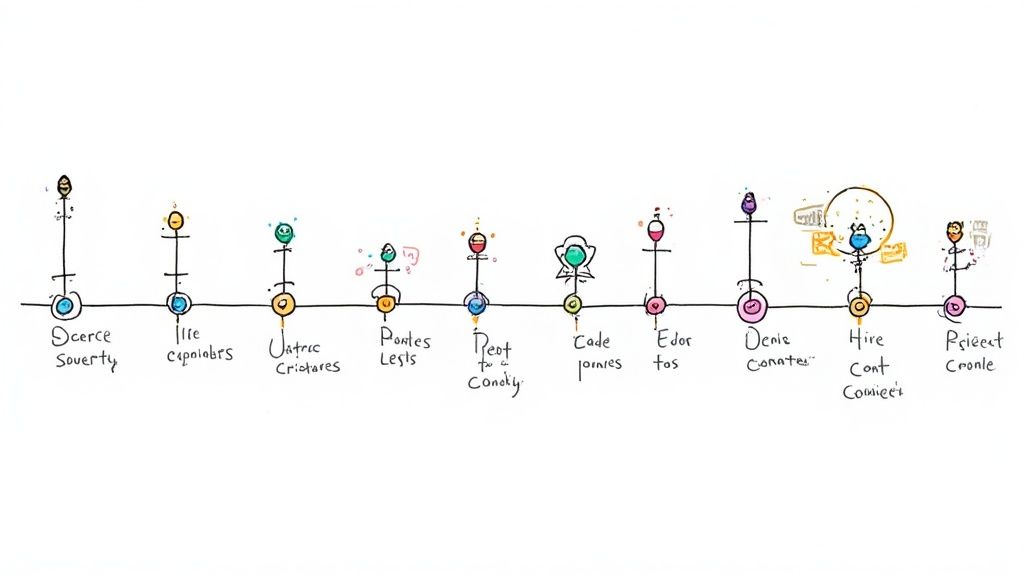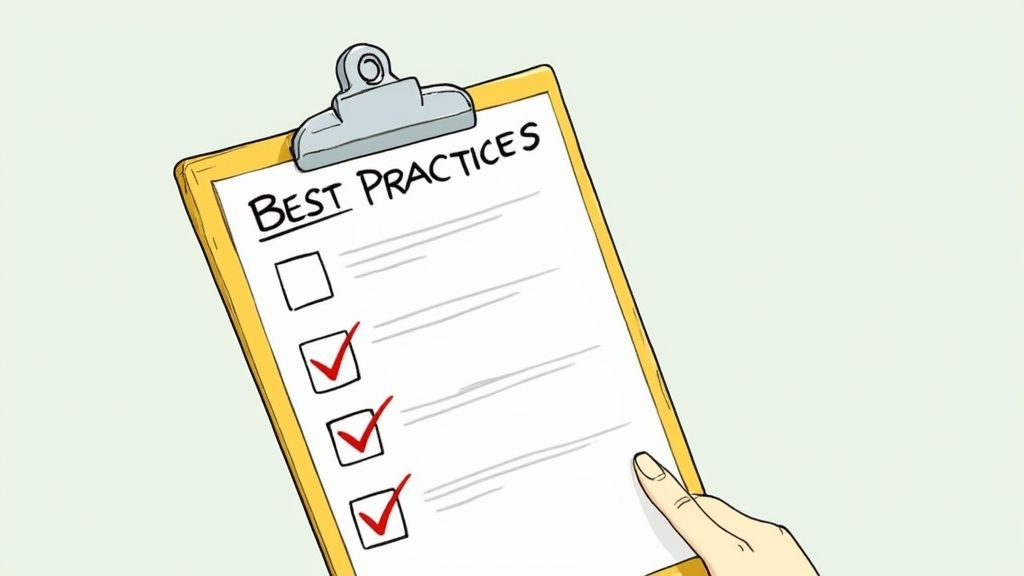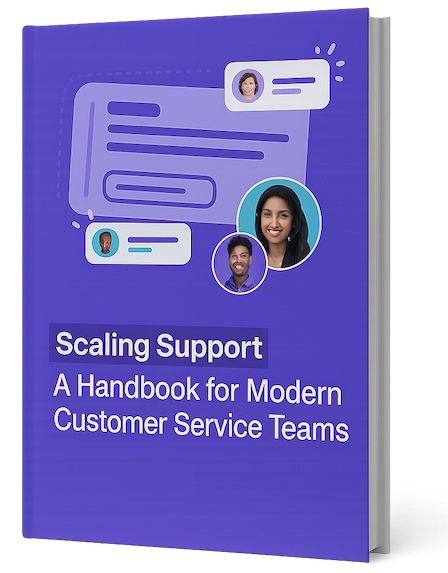Understanding the Foundations of Effective SLAs
A Service Level Agreement (SLA) creates the framework for success between service providers and their clients. It establishes expectations, enables clear communication, and builds stronger business relationships. Let's explore the essential elements that make SLAs work effectively as business tools rather than just contractual documents.
Key Components of a Robust SLA
A well-designed SLA needs several core elements working together, similar to how different parts come together to create a reliable system:
-
Clear Service Scope: Define exactly what services are included – and what aren't. For example, a website hosting SLA might specify server uptime guarantees but not cover routine security updates.
-
Measurable Metrics: Track performance using concrete numbers like uptime percentages, response times, and resolution rates. These data points help both parties monitor service quality objectively.
-
Reporting Mechanisms: Regular performance reports show trends and highlight areas needing attention. Think of these reports as health checkups that catch small issues before they become major problems.
-
Escalation Procedures: Establish clear steps for handling service issues. Like an emergency response plan, this ensures the right people get involved at the right time to minimize disruptions.
-
Review and Update Process: Business needs change over time, and SLAs should adapt. Regular reviews help keep agreements relevant and effective.
Moving Beyond the Traditional SLA Approach
Many older SLAs focus only on penalties when standards aren't met. A better approach emphasizes working together for mutual success through:
-
Shared Ownership: Both parties should actively participate in meeting SLA goals. This creates true partnership instead of an us-versus-them dynamic.
-
Continuous Improvement: The SLA should flex and grow as needs change. Regular updates help both sides deliver better results over time.
-
Open Communication: Regular check-ins help catch potential issues early. Like preventive maintenance, good communication keeps small problems from growing into major disruptions.
By following these core practices, organizations can use SLAs to strengthen business relationships and drive real improvements. This collaborative mindset transforms SLAs from static documents into tools that help both parties succeed.
Setting Clear Response and Resolution Timeframes

Setting clear response and resolution timeframes is essential for any service level agreement (SLA). Having defined timeframes builds customer trust and helps teams work efficiently. Just like a train schedule, it gives customers confidence their issues will be handled promptly while allowing support teams to plan their work effectively.
Structuring Tiered Response Times
Support issues vary greatly in urgency and impact. A tiered approach helps prioritize based on severity – similar to how emergency rooms handle patients. For example:
- Critical outages: 15-minute response time for issues affecting all users
- Major problems: 1-hour response time for issues impacting some users
- Minor issues: 4-hour response time for bugs or feature requests
This system ensures the most urgent matters get immediate attention while managing resources sensibly. Learn more about SLA best practices here.
Setting Realistic Resolution Times
Resolution times need more flexibility than response times. A password reset might take minutes while debugging a complex network issue could require hours of investigation across multiple teams. The best approach is to:
- Provide resolution time ranges rather than fixed deadlines
- Adjust times based on issue type and complexity
- Set clear expectations about what resolution means
- Build in buffer for unexpected complications
Maintaining Quality Under Pressure
Even with solid timeframes, challenges like high ticket volumes or staff shortages can impact service delivery. To handle these situations effectively:
- Create clear escalation procedures
- Develop contingency plans for peak periods
- Establish communication protocols for delays
- Train teams on handling high-pressure scenarios
- Review and adjust processes regularly
Good planning helps teams maintain service standards even during difficult times. The key is having systems in place before they're needed.
Measuring and Monitoring SLA Performance

SLA monitoring helps organizations understand service quality and identify areas for improvement. Think of it like tracking vital signs – just as doctors monitor key health metrics, companies need systems to assess if services meet the standards promised to customers. Regular monitoring helps catch potential issues early, before they affect the customer experience.
Implementing Comprehensive Monitoring Systems
Good SLA performance tracking starts with the right monitoring setup. Your system should measure metrics that directly relate to your service promises. For example, if you guarantee 99.9% uptime, you'll want to track server availability and response times. Real-time monitoring also helps teams spot and fix problems quickly, keeping service running smoothly.
Key Metrics for SLA Monitoring
Choose metrics that connect clearly to your service commitments. A help desk might focus on first response time and resolution speed, while cloud services track uptime and error rates. One key measure is the SLA adherence rate – the percentage of time you meet service promises. For instance, a 95% adherence rate means you hit targets 95 out of 100 times. Higher rates typically mean better customer retention. Learn more about SLA adherence rates.
Building Effective Performance Dashboards
Numbers alone don't tell the full story – you need clear ways to understand and act on the data. Well-designed dashboards help teams spot trends and make smart decisions. Focus on showing the most important metrics in simple, easy-to-grasp ways. Tools like Supportman can help teams share and discuss performance data efficiently.
Frameworks for Effective Monitoring
A solid monitoring approach needs clear steps for handling issues. Set specific thresholds that trigger action when metrics drop too low. Document your monitoring process so everyone knows what to track and how to respond. Review and update your approach regularly to keep up with changing service needs and new tools. This helps maintain consistent, high-quality service that matches what you promised customers.
Implementing Effective Communication Protocols
A well-designed communication system is essential for any successful service level agreement (SLA). When all parties communicate clearly and consistently, it creates natural alignment around shared goals, improves transparency, and leads to better service delivery.
Establishing Clear Escalation Paths
Having a clear process for who to contact when issues arise is critical. An escalation path provides structure and ensures problems reach the right people quickly. This prevents confusion and speeds up issue resolution.
Key escalation levels include:
- First Level Support: Handles initial contact and common issues
- Second Level Support: Addresses complex technical problems
- Management Escalation: Manages critical situations
Each level needs documented responsibilities and contact details to remove any ambiguity.
Designing Effective Reporting Mechanisms
Regular reporting helps track SLA performance and identify areas for improvement. Reports should be clear, focused, and easy to understand.
Essential report types:
- Performance Reports: Track key metrics and trends using tools like Supportman
- Incident Reports: Document specific issues with root cause analysis
- Executive Summaries: Provide high-level performance overview
Agree on report frequency and format upfront based on stakeholder needs.
Implementing Proactive Communication
Taking a proactive approach to communication helps prevent issues before they impact service. This maintains healthy client relationships and service quality.
Key proactive practices:
- Regular Updates: Share performance metrics and maintenance schedules
- Early Warnings: Alert stakeholders to potential issues promptly
- Open Channels: Foster ongoing dialogue and feedback
Modern communication tools make these processes smoother and more efficient. Features like instant messaging and real-time updates help teams collaborate better and respond faster to issues. This builds stronger relationships based on open communication and trust.
Following these service level agreement best practices creates a robust foundation for effective SLA management.
Managing SLA Reviews and Updates

Good service level agreement best practices involve more than just creating the initial document. Your SLAs need regular review and updates to stay useful and meaningful. This hands-on approach helps ensure your agreements continue to meet business needs while building stronger client relationships.
Why Regular Reviews Are Essential
Consistent SLA reviews help keep agreements matched with your business goals and what customers expect. This ongoing improvement helps catch potential issues early, prevents confusion, and builds better partnerships with clients. For instance, when you update your services or upgrade systems, you'll likely need to adjust existing agreements.
Implementing a Systematic Review Process
A structured approach makes SLA reviews thorough and productive. This includes regular stakeholder meetings, analyzing performance data, and gathering feedback from both internal teams and clients. Tools like Supportman can help by providing a central hub for communication and sharing data.
Key steps for your SLA review process:
- Schedule Regular Reviews: Plan reviews quarterly or annually to ensure consistent evaluation
- Gather Performance Data: Track key metrics like uptime, response times, and resolution rates
- Solicit Feedback: Get input from both internal teams and clients to understand what's working
- Document Changes: Keep detailed records of SLA updates and the reasons behind them
Incorporating Stakeholder Feedback
Good SLAs come from working together. Getting feedback from both internal teams and clients gives important insights into what's working and what needs improvement. This open communication creates shared ownership and helps agreements succeed. For example, clients might point out where service falls short, while internal teams can highlight operational challenges.
Best Practices for Updating Your SLAs
Updating SLAs works best as an open, collaborative process. Clear client communication helps them understand why changes are needed and lets them provide input. Keeping track of SLA versions creates a helpful record of how agreements have changed. Key practices to follow:
- Communicate Clearly: Explain updates to clients in simple, direct terms
- Be Proactive: Plan ahead for future needs rather than just reacting to problems
- Maintain Version Control: Track different versions to monitor changes and keep everyone using the latest agreement
Following these service level agreement best practices helps organizations keep their SLAs as useful tools that improve service and strengthen client relationships. This approach helps businesses stay competitive by consistently delivering quality service that meets or exceeds what customers need.
Creating Successful SLA Documentation

A strong Service Level Agreement (SLA) document defines clear service expectations while protecting both parties. Like a detailed blueprint, it sets standards and guides ongoing service delivery.
Making SLAs Clear and Effective
The best SLAs avoid complex jargon and directly state what each party can expect. Think of it as a map showing the path to great service – it should leave no room for confusion about roles and responsibilities.
Visual elements make SLAs more digestible. Adding flowcharts and tables helps break down tricky concepts, similar to how diagrams help explain complex ideas in textbooks.
Building Your SLA Framework
Using consistent templates creates reliable, complete SLA documentation. Essential components to include:
- Service Details: Clearly define what's included and excluded from the service scope
- Performance Standards: List specific, measurable targets that show service quality
- Terms and Remedies: Outline consequences if targets are missed, plus rewards for exceeding them
Making SLAs Work for Everyone
Your SLA needs to work for technical and non-technical readers alike. Use simple language that any stakeholder can understand. Digital formats with interactive elements make the document more useful.
Like any important document, SLAs should change as your organization grows. Regular reviews help ensure the agreement matches your current service capabilities and needs.
Following these principles helps create SLAs that benefit everyone involved. For support teams focused on improvement, Supportman offers tools to gather insights and enhance service quality through user feedback. Try Supportman free to see how it can strengthen your support processes.


